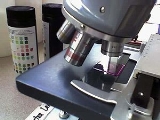Why purple dye is used in RBC staining?
replied to: suvesh123
Replied to: Why purple dye is used in RBC staining?
Certain single dye solutions may stain tissue elements in colors in colors different from the apparent color of the dye solution. This staining is most often observed as a range of staining colors. This differs from orthochromatic staining, which is most typically seen. Orthochromatic staining refers to staining of the dye is consistent with the appearance of the dye solution. ( i.e. a blue stain, imparts a blue color).
The phenomenon of metachromatic staining, or staining in a color range different from the appearance of the dye solution, is attributed primarily to basic or cationic dyes. This is accomplished by dye homologues and variants within the dye solution, which interact with different tissue elements and cause a color shift in the final staining result. This type of staining is called metachromasia.
A partial list of cationic dyes, which may exhibit metachromatic staining, would include:
Methylene Blue
Azure A, B, and C
Thionin
Toluidine Blue
Celestine Blue
Safranin
Crystal Violet
Methyl Violet
Many tissue elements will stain metachromatically; such as cartilage, Amyloid, mast cells, hyaluronic acid, and sulfated acid mucosubstances. The mechanism of metachromatic staining is not completely understood. Many common histology stains exhibit metachromatic effects. The most famous and commonly used, being metachromatic stain is the Giemsa technique. The Giemsa stain combines the basic dye Methylene blue, with the acid dye Eosin Y. This is often referred to as a “neutral” dye solution, due to the presence of acid and basic dye groups. This neutral dye solution preparation produces a range of colors that is also called a “Romanowsky” color range. The so-called Romanowsky color range can be considered an example of the metachromatic staining phenomenon. The use of one dye solution that reacts in metachromatic fashion allows the visualization and differentiation of many different cells types and is commonly used in blood smear prepartions to show RBC's and WBCs, bacteria and inclusions.

